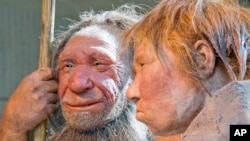You might feel right at home in the living space of a Neanderthal. Well, maybe not exactly, but the layout may at least look familiar. New research says they organized their living spaces around certain activities, much like we do.
The study shows that man’s ancestors butchered animals, made tools and gathered round the fire in different parts of their shelters.
“There has been this idea that Neanderthals did not have an organized use of space, something that has always been attributed to humans,” said Julien Riel-Salvatore, assistant professor of anthropology at the University of Colorado Denver and lead author of the study. “But we found that Neanderthals did not just throw their stuff everywhere but in fact were organized and purposeful when it came to domestic space.”
Using excavations at a collapsed rock shelter at Riparo Bombrini in Italy that was once inhabited by Neanderthals and humans for thousands of years, the archeologists found that the Neanderthal portions were divided into different areas for different activities.
The top level was used as a task site, likely a hunting stand, where they could kill and prepare game. The middle level was a long-term base camp and the bottom level was a shorter term residential base camp.
Riel-Salvatore and his team found a high frequency of animal remains in the rear of the top level, indicating that the area was likely used for butchering game.
In the middle level, which has the densest traces of human occupation, artifacts were distributed differently. Animal bones were concentrated at the front rather than the rear of the cave. This was also true of the stone tools, or lithics. A hearth was in back of the cave about half a meter to a meter from the wall. It would have allowed warmth from the fire to circulate among the living area.
The discoveries are the latest in continuing research showing that Neanderthals were far more advanced than originally thought, creating bone tools, ornaments and projectile points.
“This is ongoing work, but the big picture in this study is that we have one more example that Neanderthals used some kind of logic for organizing their living sites,” Riel-Salvatore said. “This is still more evidence that they were more sophisticated than many have given them credit for. If we are going to identify modern human behavior on the basis of organized spatial patterns, then you have to extend it to Neanderthals as well.”
The study was published in the latest issue of the Canadian Journal of Archaeology.
The study shows that man’s ancestors butchered animals, made tools and gathered round the fire in different parts of their shelters.
“There has been this idea that Neanderthals did not have an organized use of space, something that has always been attributed to humans,” said Julien Riel-Salvatore, assistant professor of anthropology at the University of Colorado Denver and lead author of the study. “But we found that Neanderthals did not just throw their stuff everywhere but in fact were organized and purposeful when it came to domestic space.”
Using excavations at a collapsed rock shelter at Riparo Bombrini in Italy that was once inhabited by Neanderthals and humans for thousands of years, the archeologists found that the Neanderthal portions were divided into different areas for different activities.
The top level was used as a task site, likely a hunting stand, where they could kill and prepare game. The middle level was a long-term base camp and the bottom level was a shorter term residential base camp.
Riel-Salvatore and his team found a high frequency of animal remains in the rear of the top level, indicating that the area was likely used for butchering game.
In the middle level, which has the densest traces of human occupation, artifacts were distributed differently. Animal bones were concentrated at the front rather than the rear of the cave. This was also true of the stone tools, or lithics. A hearth was in back of the cave about half a meter to a meter from the wall. It would have allowed warmth from the fire to circulate among the living area.
The discoveries are the latest in continuing research showing that Neanderthals were far more advanced than originally thought, creating bone tools, ornaments and projectile points.
“This is ongoing work, but the big picture in this study is that we have one more example that Neanderthals used some kind of logic for organizing their living sites,” Riel-Salvatore said. “This is still more evidence that they were more sophisticated than many have given them credit for. If we are going to identify modern human behavior on the basis of organized spatial patterns, then you have to extend it to Neanderthals as well.”
The study was published in the latest issue of the Canadian Journal of Archaeology.








